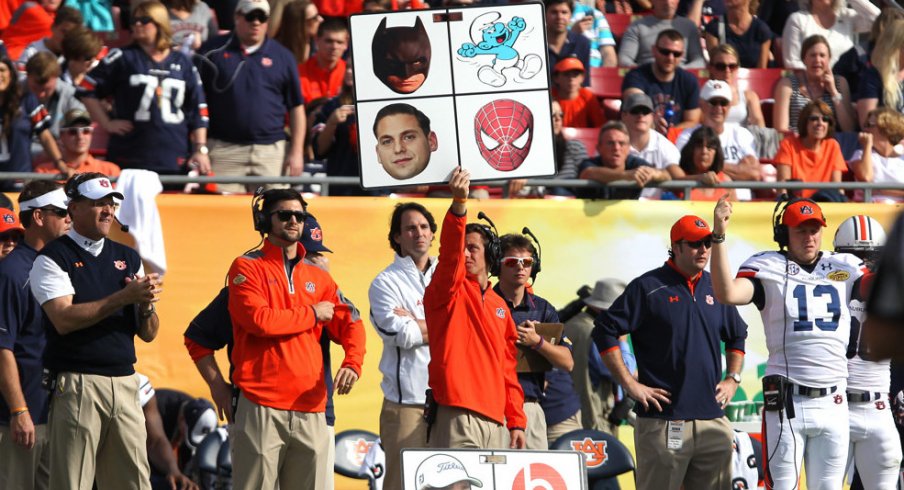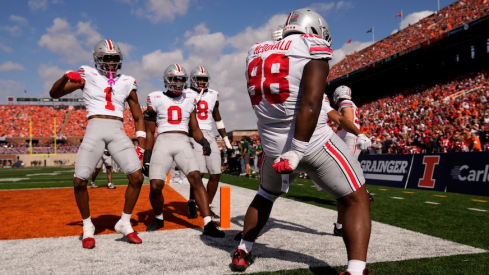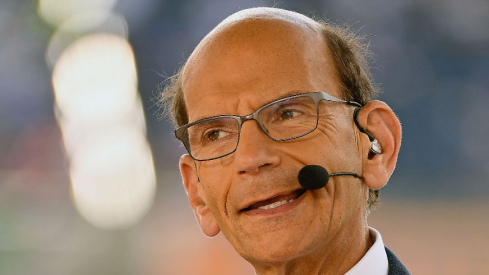This is the final installment of our in-depth look at No-Huddle offenses and how they've changed the landscape of college football. Part 1 examined the philosophy behind changing an offense's tempo, while Part 2 discussed how tempo impacts an offense's play-calling.
Not long after Chip Kelly took over the University of Oregon offense in 2007, transforming it into the high-octane scoring machine that has come to define the program ever since, some interesting characters began showing up on the Ducks' sideline. Standing high above the heads of coaches and backup quarterbacks feverishly sending in hand signals to the players on the field were the faces of numerous celebrities, superheroes, animals, and countless other seemingly random symbols, spread into one of four quadrants on a giant poster board.
These confusing signs began receiving more and more TV air time as their increasing presence seemed to coincide with the success of Kelly's offense, which grew to become one of the most uniquely dangerous units in the nation. Analysts could only guess what the symbols meant, as Oregon coaches refused to disclose their exact meaning. As time has gone on, countless college and high school programs have adopted the approach, leading to more and more visual collections appearing on sidelines across America each fall.
But while the novelty of seeing Ron Burgundy's face play a role in a critical 3rd down still remains today, the use of such a method underscores a much larger, and often overlooked aspect of the game. Many football fans are used to the NFL game, which allows the quarterback and middle linebacker receive the play-call directly from a coach via a radio inside their helmet (one of many innovations Ohio football deity Paul Brown gave to the game). Outside of the professional level though, coaches have always had to find different means of communicating with their charges on the field.
Brown's tinkering with radios was a replacement for his initial play-calling method, in which he rotated two players between the same position on every play. His play would be told to the substituting player, who would relay it to the quarterback, who would then relay it to the rest of the huddle. This is a common method still used today, especially at the pee-wee and junior high levels.
But for coaches that want to move quickly between plays, don't want to substitute in such a pattern, or whose players don't even huddle at all, this method of communication is clearly not an option. Instead, these coaches have often fallen into one of two camps: those that use wrist cards or those that rely on symbols.
The big difference between the two is not the physical method by which the play is actually communicated, as the process of using countless hand signals, pictures, cards or even just yelling a code word can be seen in both systems. Rather, the difference is a philosophical one that ties back directly to the way coaches communicate their playbook in general.
Coaches that use wrist cards believe in the idea of taking their existing, larger playbook and shrinking parts of it down to what can fit on the card inside a player's wristband. Some of these wristbands offer room for as many as 84 plays, and the coaches simply need to signal where the players should look on the card to know the play call (such as 'Red 7' meaning look to the red column, row 7). Some uptempo systems will give the wristbands to every skill position player, allowing receivers to move directly to their pre-snap alignment, while giving the quarterback or running back the responsibility of communicating the call to the offensive line.
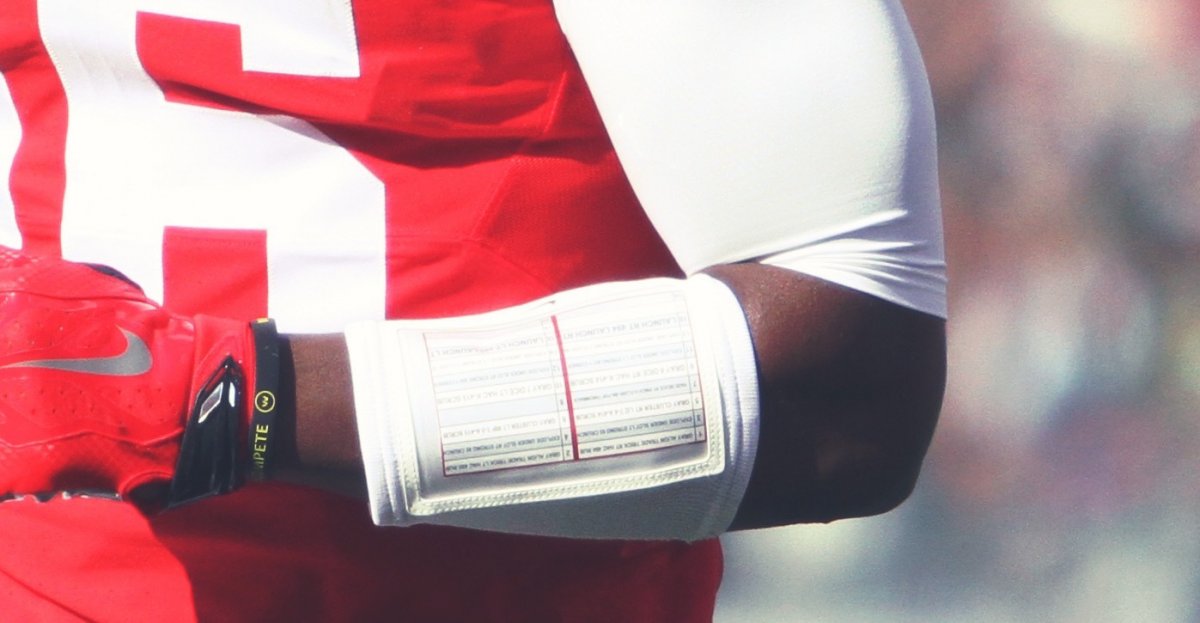
There are obvious benefits to such a system, as the play sheet can be changed at any time, be it week-to-week or series-to-series, as the communication system itself does not change, just what it signals. Additionally, it's relatively easy to implement this philosophy, as players aren't constantly learning new signals throughout the season.
However, the system lacks the one thing that true no-huddle believers value most: speed. The time needed for players to all see the signals from the sideline, find the play on their card, and then get to their spot to line up might not seem very long, but every second is precious when team is trying to snap the ball before the defense is ready.
Such a need facilitated the development of 'symbol' systems, which brought with it a fundamental shift in the way players and coaches not only communicate, but in the way they're taught. Instead of basing play calls on numbers associated with patterns in a route tree, which tells every player exactly where they're supposed to go, coaches began teaching the full concepts to each player, and identifying them with short, easy-to-remember names like snag, smash, or sail.
After learning all the different routes or blocking assignments in a specific concept, players should theoretically know which one they're supposed to execute once it's paired with a formation. For instance, if a formation calls for there to be two receivers split out on the same side as a tight end, and the play called is the 'snag' concept, the tight end knows that as the #3 receiver to that side he should run the flat arrow route to the sideline.
The beauty of the symbol system is that it can create literal links for the players to understand, as they are often involved in the development for the signals that symbolize a specific play. As an example, the signaler might clap his two hands together as if he were smashing something to symbolize the 'smash' concept.
With this method in place, it becomes very easy for teams to add in new concepts from week to week, as there is literally no limit to the number of symbols that can be created and what they stand for. This is of course where the aforementioned signs from Oregon come into play. It's much easier to simply show a new image which has its own meaning rather than coming up with a hand signal for a new concept that may be added to the game plan.
There are still some downsides to using the symbol system, though. First, for a team to operate in this mindset, they must communicate with them at all times in practice. The language of symbols must be ingrained into their memory like a second language.
Second, the system is very simplistic in its approach, which has made the jobs of NFL talent evaluators far more difficult. The majority of college teams that run uptempo offenses communicate with the symbol system, per a recent study conducted by X and O labs, making the questions asked of Cam Newton's ability to read a defense in 2011 even more common just a few years later.
But college coaches are paid to win games, not develop NFL quarterbacks (although the recruiting aspect of this issue could certainly merit debate).
However, there is one final downside to the philosophy of using symbols, as there is a strong possibility of these symbols being decoded by one's opponent. For a team like Ohio State, which runs the same 'tight zone' play dozens, if not hundreds, of times over the course of a season, they must complicate their system of communication in order to avoid their signs from being stolen.
To do so, teams will often break up their communications into as many as four different pieces, regardless of whether they use wristbands or symbols:
- Personnel
- Formation
- Snap Count
- Play/Concept
From where each piece of info will come from often changes on every series, with countless fake signals included to throw off any potential thieves. Once all these pieces are put together, the result can be overwhelming to anyone trying to spot a pattern.
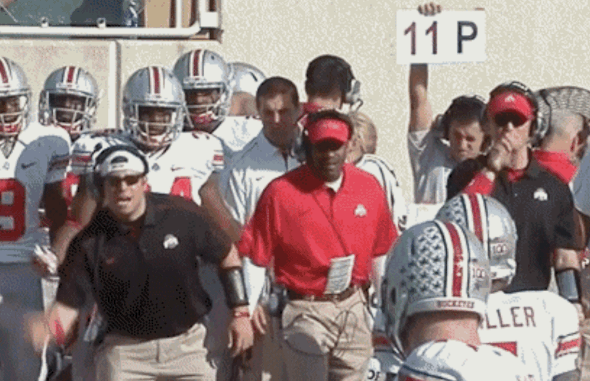
There are endless ways in which a play call can physically be communicated in an uptempo offense, with the the only common trait between any two teams being that they're individually distinct. While much in the game of football is copied and passed down from coach to coach, the way in which every team builds their specific method of communication is truly unique.
Though there is no 'wrong' way to set up a team's communication structure, there are wrong ways to implement it. Much like the way an entire offense must buy into the philosophy of going uptempo, they must also be willing to put in the work to learn the system of communication.
Regardless of how long a player or coach has been in a program, they must be willing to adopt a new language every summer in training camp. From the starting quarterback to a walk-on wideout, the head coach to a graduate assistant, every person involved in the offense must commit to fully transitioning an uptempo philosophy into a reality.
